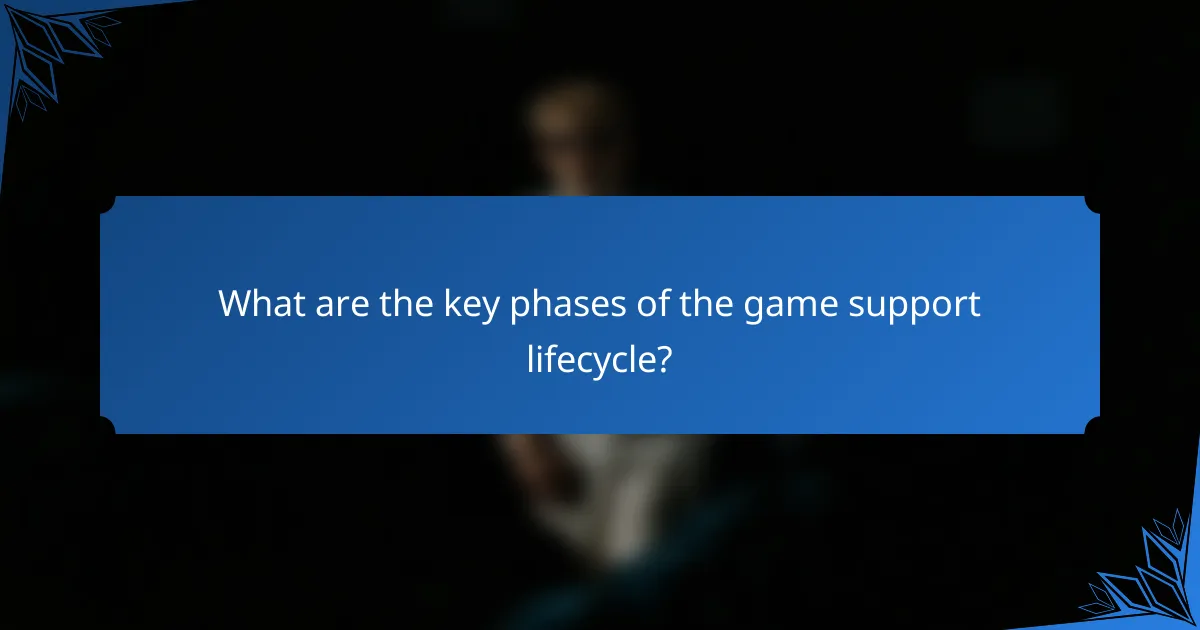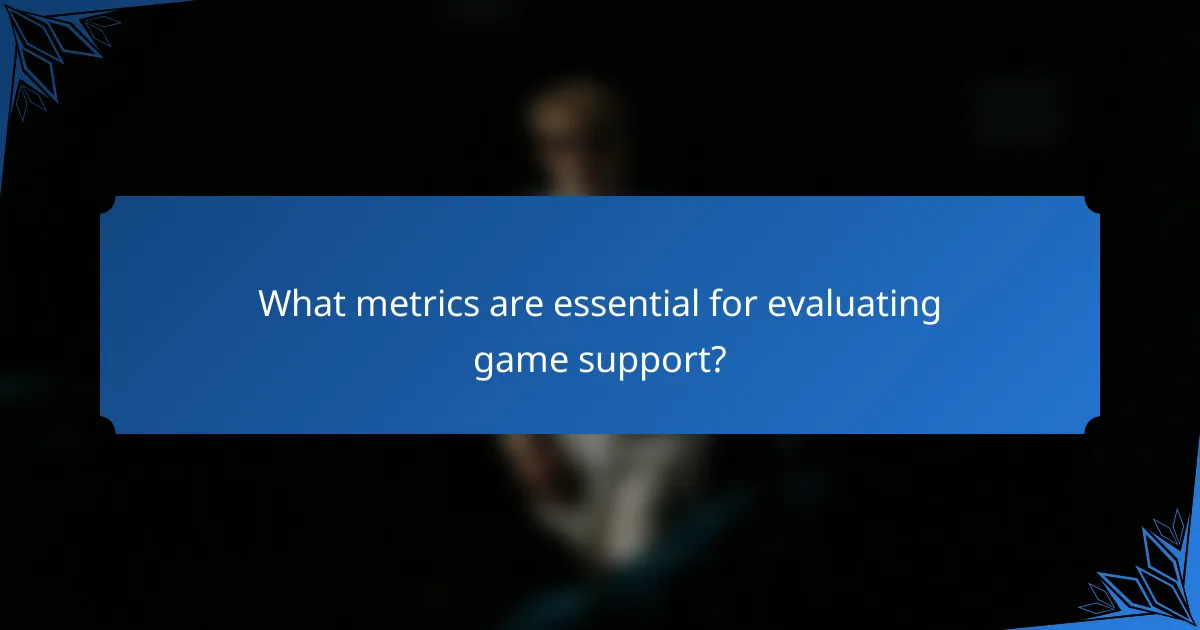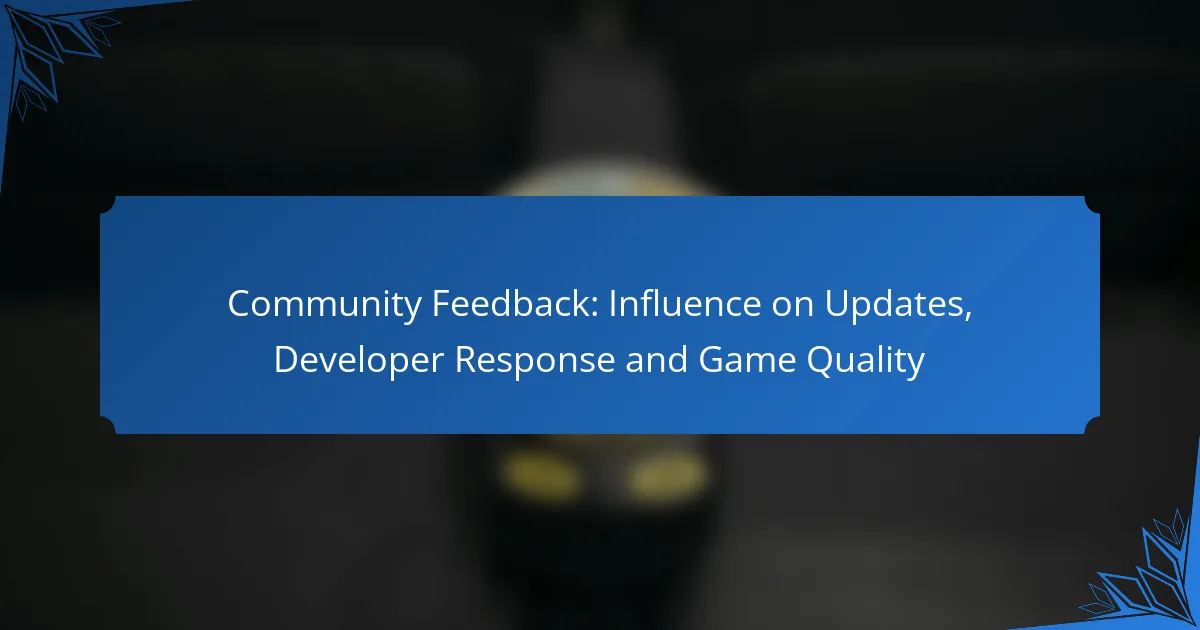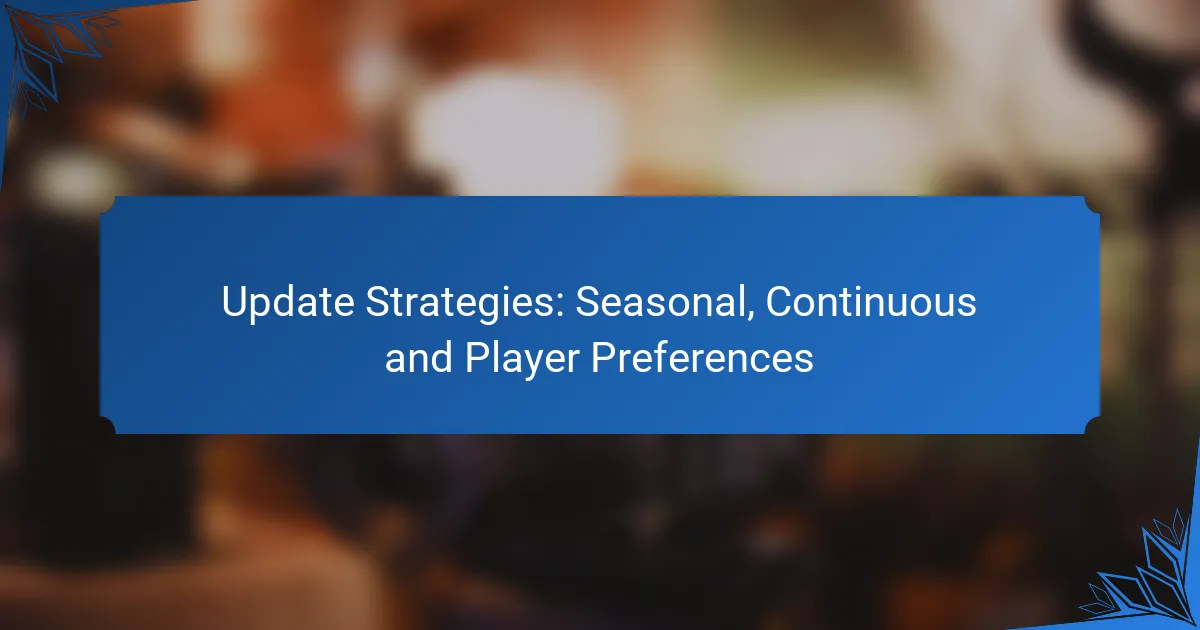The game support lifecycle encompasses three essential phases: launch, updates, and sunset. Each phase is vital for maintaining player engagement and satisfaction, starting from the initial launch that sets the tone for player interest, through updates that enhance the experience, to the eventual sunset phase that gracefully concludes the game’s journey.

What are the key phases of the game support lifecycle?
The game support lifecycle consists of three key phases: launch, update, and sunset. Each phase plays a crucial role in the overall success and longevity of a game, influencing player engagement and satisfaction.
Launch phase
The launch phase is when a game is released to the public, marking its entry into the market. This phase involves extensive marketing efforts, server preparations, and community engagement to ensure a smooth rollout.
Key considerations during the launch include testing for bugs, optimizing server capacity, and gathering initial player feedback. A successful launch can lead to strong early sales and a dedicated player base.
Update phase
The update phase follows the launch and focuses on enhancing the game based on player feedback and ongoing performance metrics. Regular updates can include new content, bug fixes, and balance adjustments to keep the game fresh and engaging.
It’s essential to establish a clear schedule for updates, whether they are weekly, monthly, or quarterly. Communicating upcoming changes to players can help maintain interest and encourage continued play.
Sunset phase
The sunset phase occurs when a game is gradually phased out of active support, often due to declining player engagement or the introduction of new titles. This phase involves informing players about the end of support and providing them with closure.
During the sunset phase, developers may offer final updates, special events, or incentives for players to transition to newer games. Clear communication about the timeline and reasons for the sunset can help mitigate player dissatisfaction.

How do game launches impact player engagement?
Game launches significantly influence player engagement by determining initial interest and long-term retention. A well-executed launch can create a strong player base, while a poorly managed one may lead to quick drop-offs.
Initial player acquisition
Initial player acquisition is crucial for establishing a game’s presence in the market. Effective strategies often include targeted marketing campaigns, influencer partnerships, and pre-launch promotions. Offering incentives like early access or exclusive in-game items can attract players and boost initial downloads.
Consider utilizing social media platforms and gaming forums to generate buzz before launch. Engaging with potential players through teasers and beta testing can also create anticipation and encourage word-of-mouth referrals.
Community building strategies
Building a community around a game enhances player engagement and loyalty. Developers should focus on creating channels for communication, such as forums, Discord servers, or social media groups, where players can share experiences and feedback. Regular interaction with the community fosters a sense of belonging.
Organizing events, such as in-game competitions or live streams, can further strengthen community ties. Additionally, actively responding to player feedback and implementing suggestions can show that developers value their players, leading to increased retention and satisfaction.

What are effective strategies for game updates?
Effective strategies for game updates involve a mix of content expansion, bug fixes, and integrating player feedback. These approaches ensure that the game remains engaging, performs well, and meets the expectations of its community.
Content expansion
Content expansion includes adding new features, levels, characters, or game modes to enhance player experience. Regular updates can keep the game fresh and encourage players to return, especially if the new content aligns with player interests.
Consider seasonal events or themed updates that resonate with current trends or holidays. For example, introducing a Halloween-themed event can attract players looking for festive content. Aim for updates every few months to maintain engagement without overwhelming players.
Bug fixes and performance improvements
Addressing bugs and improving performance is crucial for maintaining player satisfaction. Regularly monitor player reports and analytics to identify common issues that may disrupt gameplay.
Implement a structured approach to bug fixes, prioritizing critical issues that affect gameplay or user experience. Aim to release patches within a few weeks of identifying significant bugs, ensuring that players feel heard and valued.
Player feedback integration
Integrating player feedback into updates helps tailor the game to its audience. Actively solicit feedback through surveys, forums, or social media to understand what players want or dislike.
Establish a feedback loop where players see their suggestions implemented in future updates. This not only improves the game but also fosters a sense of community and loyalty among players. Consider dedicating a section of your update notes to highlight changes made based on player input.

How to manage the sunset phase of a game?
Managing the sunset phase of a game involves planning for its end while ensuring players feel valued and informed. This phase requires clear communication, support for transitioning to new titles, and strategies to maintain community engagement until the final shutdown.
Communicating with players
Effective communication is crucial during the sunset phase. Inform players well in advance about the game’s discontinuation, detailing the timeline and reasons behind the decision. Utilize multiple channels such as in-game notifications, email newsletters, and social media to reach your audience.
Provide regular updates throughout the sunset phase, including any changes to gameplay, support availability, and final events. Transparency helps maintain trust and allows players to prepare for the transition, reducing frustration and disappointment.
Transitioning to new titles
As a game approaches its sunset, offer players clear pathways to new titles. This could include promotional discounts, exclusive in-game items, or early access to upcoming releases. Highlight how the new titles build on the strengths of the old game, ensuring players see the value in making the switch.
Consider hosting events or challenges that encourage players to explore new games while still engaging with the current title. This helps maintain community spirit and eases the transition, making players feel supported rather than abandoned.

What metrics are essential for evaluating game support?
Essential metrics for evaluating game support include player retention rates, update frequency, and community engagement levels. These indicators help developers understand player satisfaction, the effectiveness of updates, and the overall health of the game’s community.
Player retention rates
Player retention rates measure the percentage of players who continue to engage with a game over time. High retention rates indicate that players find the game enjoyable and are likely to return, while low rates can signal issues that need addressing.
To improve retention, developers should focus on creating engaging content and addressing player feedback. A common benchmark is to aim for a retention rate of at least 40% after the first month, although this can vary by genre.
Update frequency
Update frequency refers to how often a game receives new content, bug fixes, or improvements. Regular updates keep the game fresh and demonstrate to players that the developers are committed to enhancing their experience.
Developers should establish a consistent schedule for updates, whether it’s weekly, bi-weekly, or monthly. Aiming for at least one significant update every few months can help maintain player interest and engagement.
Community engagement levels
Community engagement levels reflect how actively players participate in discussions, events, and feedback channels. A vibrant community can enhance the game’s longevity and provide valuable insights for developers.
To foster engagement, developers should encourage player interaction through forums, social media, and in-game events. Monitoring metrics like forum activity or social media mentions can help gauge community health. Aim for a steady increase in engagement metrics to ensure a thriving player base.

What are the prerequisites for a successful game launch?
A successful game launch requires thorough planning, robust testing, and effective marketing strategies. Key factors include understanding the target audience, ensuring technical stability, and creating buzz around the game prior to release.
Understanding the target audience
Identifying and understanding your target audience is crucial for a successful game launch. Conduct market research to determine player preferences, demographics, and gaming habits. Tailoring your game’s features and marketing efforts to resonate with this audience can significantly enhance engagement and sales.
Consider creating player personas to visualize your audience segments. This can guide design choices, promotional content, and community engagement strategies, ensuring that your game meets the expectations and desires of its intended players.
Technical stability and testing
Ensuring technical stability is vital for a smooth launch. Rigorous testing phases, including alpha and beta testing, help identify and resolve bugs, performance issues, and gameplay imbalances. Aim for a polished experience to minimize negative feedback and player frustration at launch.
Utilize automated testing tools alongside manual testing to cover a wide range of scenarios. Focus on critical aspects such as load times, server stability, and compatibility across devices. A well-tested game can significantly improve player retention and satisfaction.
Effective marketing strategies
Effective marketing strategies are essential for generating excitement before a game launch. Utilize social media, influencer partnerships, and targeted advertising to reach potential players. Create engaging content, such as trailers and gameplay videos, to showcase your game’s unique features.
Consider hosting pre-launch events or beta access opportunities to build community interest and gather early feedback. A strong marketing campaign can create anticipation and drive initial sales, setting the stage for a successful launch.



